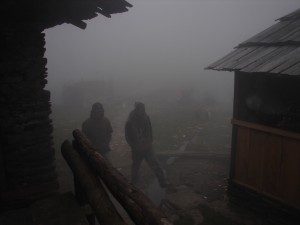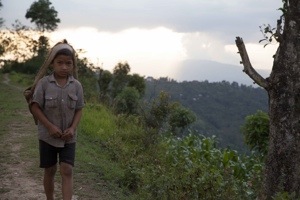 Time might be running out for collecting ancient folklore in Nepal – local history, mythology, ghost stories, fairy tales and more. Once the inherited treasure of every Nepali child, many youth are now growing up only with fragments of it. Indeed, grandparents do pass on some cultural legacy to their grandchildren, but much will disappear with them. It’s also true, though, that the past is still alive in the present – go to remote villages and Shamans will still shake the night! Here’s a list of what we have covered so far. Stay tuned for more!
Time might be running out for collecting ancient folklore in Nepal – local history, mythology, ghost stories, fairy tales and more. Once the inherited treasure of every Nepali child, many youth are now growing up only with fragments of it. Indeed, grandparents do pass on some cultural legacy to their grandchildren, but much will disappear with them. It’s also true, though, that the past is still alive in the present – go to remote villages and Shamans will still shake the night! Here’s a list of what we have covered so far. Stay tuned for more!
Contents
Video: Women shamans performing full moon rituals (Janakpur)
Moving Stars: Modern Beliefs about Satellites (Kavre)
The Pahari defeat: a local history from Saathi-ghar (Kavre)
Newari folklore: Glimpse of the “Kack” (Kathmandu valley)
Video: Women shamans performing full moon rituals
This video is from a remote village East of Janakpur – at night on the last full moon of November – capturing moments of ancient Shaman rituals. Most of them women, the local Shamans are performing rituals celebrating the slaying of a demon ages ago. The nature of the rituals? Well, they are highly physical, imprinting a mix of fear and awe in the eyes of the locals. Watch the video below and it’ll be clear why: these women shamans are powerful! Also known as Kartik Poornima, the deeper meaning of the rituals is complex. But here’s the video: it’s “Shaman Night” under a full moon.
Moving Stars: Local Beliefs about Satellites
 We were sitting around the campfire one night in December, ten years ago, just two hours outside Kathmandu. Location: Saathi-ghar. It was a chill evening – there were no clouds – and the sky was glittering with stars. But more that that: a few satellites also crossed over.
We were sitting around the campfire one night in December, ten years ago, just two hours outside Kathmandu. Location: Saathi-ghar. It was a chill evening – there were no clouds – and the sky was glittering with stars. But more that that: a few satellites also crossed over.
Two boys had joined us at the campfire and pointed to one of the moving dots above: “Look, it’s here – a moving star!” The wife of the owner of the guesthouse came out to see it too. It was known that moving stars mostly crossed over before midnight and early in the morning. This one was early.
The two boys had first seen a moving star some years back. One of them was at the toilet when the other had come knocking on the door: their first siting. Since then, they had seen them on most evenings. But it wasn’t just the boys and the people at the guesthouse who talked about it. No, the whole village knew about the moving stars. Why were these stars moving? Nobody knew for sure. But if you were about to get married, it was “good luck” to have seen a moving star together first!
 We were watching another satellite crossing the sky until barely visible above the silhoutte of the mountains. “One night I saw a moving star flying right into another star”, one of the boys said. “But it didn’t explode – it just continued right through it!” They had wondered that maybe it was the “shit of a star”.
We were watching another satellite crossing the sky until barely visible above the silhoutte of the mountains. “One night I saw a moving star flying right into another star”, one of the boys said. “But it didn’t explode – it just continued right through it!” They had wondered that maybe it was the “shit of a star”.
Is the true nature of the moving stars still unknown to them out there in Saathi-ghar? We actually don’t know. But next time we go, we’ll be sure to ask them. If they still believe in moving stars, we’ll keep the truth about satellites hidden; if they don’t, well then it’s just another folklore hereby treasured.
The Pahari defeat: a local history from Saathi-ghar
Once upon a time, some present-day VDCs were kingdoms of their own. In Saathi-ghar in Kavre, a two hour drive outside Kathmandu, the Paharis once ruled. Locals tell how these people of Terai origin had migrated up along the rivers long ago and finally settled in the forests on the ridge. Down below lay the fertile river valley – the one they had followed – and up on the higher ground, the Pahari king built his palace. Next to it, of course, his tribal priests built a temple. The only problem from the outset was that farther away, on the other side of a gorge that created a natural boundary on the ridge, lived the Chhetris – and the Chhetri king was not happy with the arrival of his new neighbours. Nor were his priests – and so hostility soon broke out. The actual cause, though, is not clear. Maybe the Chhetri king was used to hunting the forests where the Pahari tribe had settled. Or perhaps he owned that part of the ridge and now strangers of a different culture had imposed. In any case, conflict intensified and one day it came to war.The war began down at the gorge. The Chhetri king brought his men to the border between the two kingdoms and they began taking shots with bow and arrow at the Paharis. It could also be that the Paharis had started the battle. Nobody alive today knows for sure. But the outcome of the war between the two tribes is well-known by the elders in Saathi-ghar who were told this local history by their elders – many years ago. The Paharis suffered great defeat. Casualty numbers are long since forgotten but how the war culminated is not.
The war lasted just a day and ended as the Chhetris pushed forward to the palace and a Chhetri archer hit the Pahari queen with several arrows. This loss completely robbed the Pahari king and his men of their last remaining fighting spirit. In a hail of arrows the defeated tribe fled into the forest while the Chhetris began looting the palace and temple, taking everything the Pahari rulers and their people had owned. It should take many years before anyone saw the Pahari tribe again. Even at the time when the oldest people in Saathi-ghar were kids, they were warned by their elders never to walk too far into the forest or the “Paharis will take you!” A rare glimpse was all most people had.The Paharis remained an almost mythical tribe until the 1950s when severe lumber activity began around Saathi-ghar – severe from the point of view of those who love the forest. The once dense canopy fell to the ground and the lush grounds were laid bare. Of course, it didn’t take more than a couple of decades before deforestation began to show its side-effects. Water ponds evaporated, springs stopped running with fresh drinking water, and the soil dried out. But those who should suffer the worst from this change in the local environment were the Paharis. As it turned out, and as some locals of course knew already, it was only a mile or so out to the community where they lived.
Out there, water had never been the most plentiful. But it had been enough to sustain them. After their gruesome defeat to the Chhetri tribe, the Paharis had settled in the least attractive parts of the territory from an agricultural point of view – the only tract of land where they were left alone by their conquerers – and here they tilled millet, collected roots, and did petty hunting, which kept their tribe alive. The dense forest had protected whatever water sources they had. But with deforestation the drying out began. Today, access to water for drinking and irrigation remains one of the biggest problems for the Paharis. Once the rulers of a small kingdom, their area is known as ward 6: the poorest ward in Saathi-ghar. Nobody fear going there anymore and few care to either. The Paharis don’t even own the land they inhabit. The temple owns it – it’s status is “guti land”. It’s not clear for how long that was the status of the Paharis’ territory – some say since the time of the Rana regime – but in any case, the implication for the Paharis is this. They can continue to inhabit and till the land only for a rent to the temple. Ever since the Pahari community was exposed with the felling of the forest, every household had to pay a part of their harvest, bring flowers for the ceremony every Saturday, and carry the small but heavy deity worshipped at the temple around Saathi-ghar at Dashain. The Paharis were told to take pride in serving the temple and for a generation or longer, they supposedly did. But young Paharis tell that all this is changing.History leaves winners and losers behind. It happens on a grand scale when great states collide in bloody wars. But in Nepal, during the times before the many kingdoms were unified, once dotting the valleys and hills, it also happened on a small scale – such as in the otherwise long since forgotten war between the Cheetri and the Pahari king. We can’t be sure that all the details of this tale are correct – none of it was ever written down – so if anyone knows more, do add to it. Or else, post another “local history” if you know one. Big dramas have unfolded in the tiniest of places, and this one will hereby not be forgotten.
Newari folklore: Glimpse of the “Kack”
Have you ever seen a short man-like creature, about two feet tall and furry in a big way – either black or white – and mostly active at night? Well, only few have. But ask older people around Kathmandu Valley, especially among the Newars, and someone will tell you they have. It’s a friendly creature but a shy one as well: the “kack”.
Kacks are to Newari folklore what trolls and elves are to the European heritage. They move about in forests and villages by stealth – shy as they are – and stay hidden most of the time. But sometimes they might approach you: they can hide in a heartbeat but they can also appear out of nowhere. So you might be lucky to see one – or unlucky, depending on what colour it has. If you encounter a black kack, better close your eyes. See a white one, on the other hand, and you’re in luck!A white kack only means well – and seeing one brings good luck and happiness. We spoke to an elderly woman in Kathmandu who saw several kacks – all white ones. The closest encounter was with a quiet, furry fellow who came and sat on her lap! Many of those who’ve seen a kack will tell you how these “little people” would come and sit on the edge of their bed for a while, keeping them half amazed, half in shock the rest of the night. A white kack is friendly – but it can still be a bit scary.
Kacks are getting rarer nowadays and you might wonder why. Maybe they don’t feel welcome or perhaps even ignored? Well, old people who grew up in the heart of kack territory – Kathmandu – will usually tell you a simpler reason: kacks are shy creatures and so, since the capital has become crowded and noisy, many have left. Sure kacks can hide and move about by stealth, but there’s a limit. Either way, now it’s no-longer in Kathmandu but in the villages you’ll hear about kacks the most.
So to see a kack, you’ll have to find a village and stay overnight – not sure we dare. Do you?
If you know more about the kacks, do mail us or record it on audio and we’ll post it!







